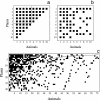The nested assembly of plant-animal mutualistic networks
- PMID: 12881488
- PMCID: PMC170927
- DOI: 10.1073/pnas.1633576100
The nested assembly of plant-animal mutualistic networks
Abstract
Most studies of plant-animal mutualisms involve a small number of species. There is almost no information on the structural organization of species-rich mutualistic networks despite its potential importance for the maintenance of diversity. Here we analyze 52 mutualistic networks and show that they are highly nested; that is, the more specialist species interact only with proper subsets of those species interacting with the more generalists. This assembly pattern generates highly asymmetrical interactions and organizes the community cohesively around a central core of interactions. Thus, mutualistic networks are neither randomly assembled nor organized in compartments arising from tight, parallel specialization. Furthermore, nestedness increases with the complexity (number of interactions) of the network: for a given number of species, communities with more interactions are significantly more nested. Our results indicate a nonrandom pattern of community organization that may be relevant for our understanding of the organization and persistence of biodiversity.
Figures



References
Publication types
MeSH terms
LinkOut - more resources
Full Text Sources

